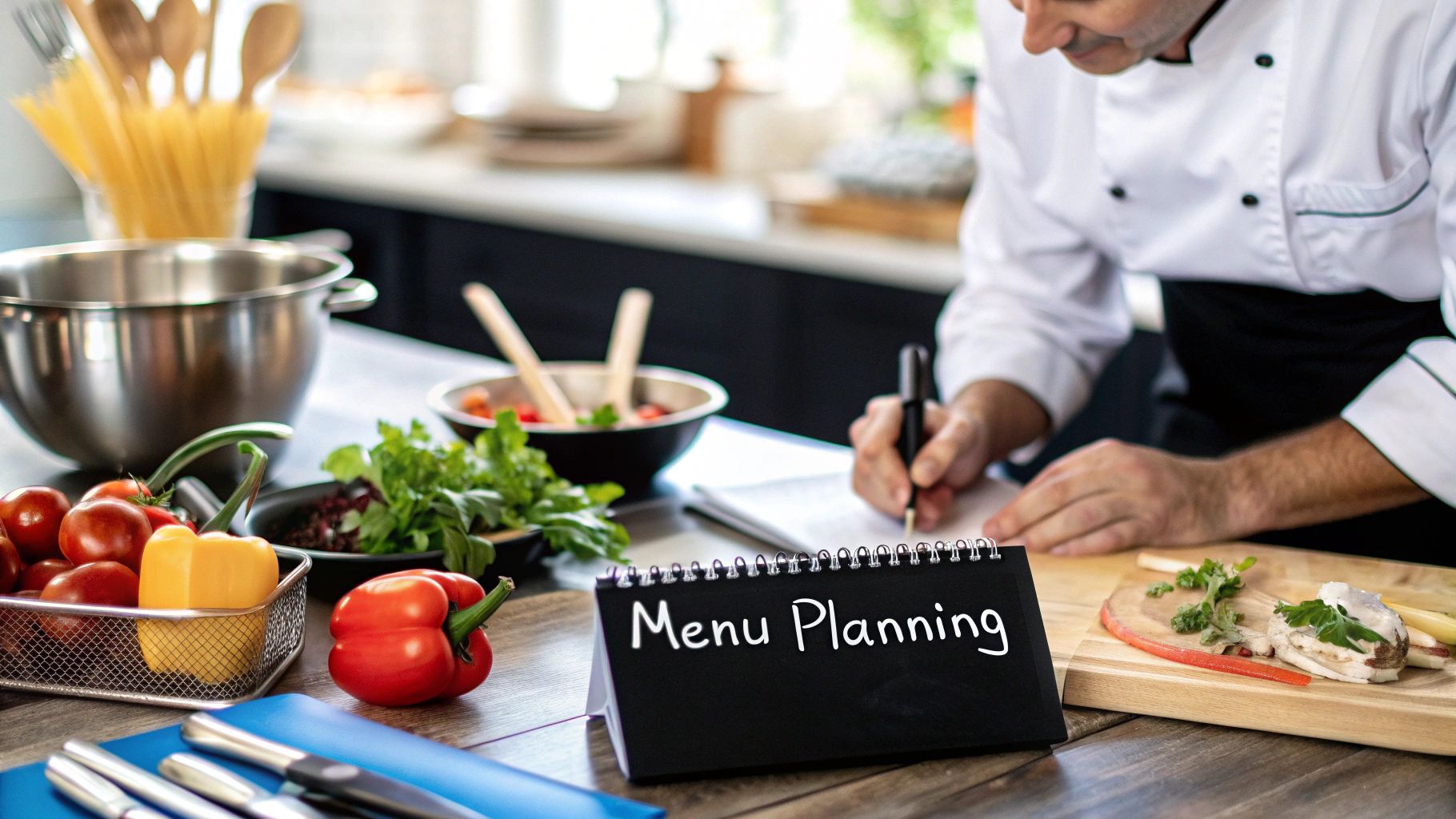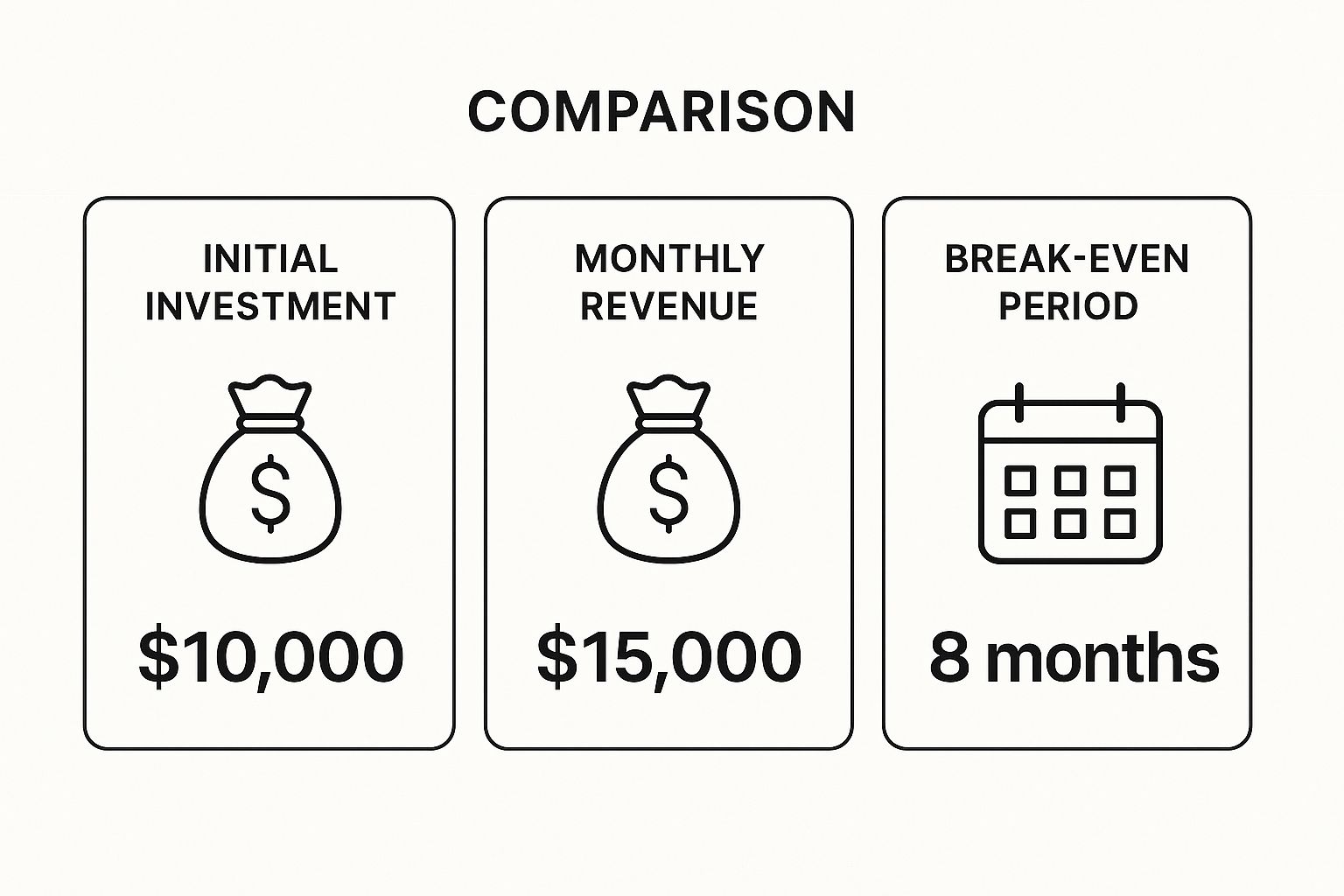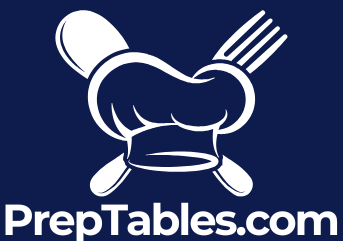
How to Start Catering Business: Your Ultimate Guide
Share
So, you’re thinking about starting a catering business. It’s an exciting venture, but it's more than just cooking great food. The real secret to success lies in the groundwork you lay before you even touch a saucepan.
It all boils down to a few key stages: figuring out your specialty, creating a rock-solid business plan, sorting out the legal stuff, and, of course, getting the word out. The journey begins by carving out a profitable corner of the market for yourself—maybe that’s upscale corporate lunches or trendy vegan weddings—and then building a smart plan around it. This foundation is what will help you secure funding, guide your day-to-day operations, and ultimately grow a business that lasts.
Your Foundation for a Thriving Catering Business

Before a single dish gets prepped, a successful catering business is built on a solid strategic foundation. So many aspiring caterers jump straight into menu planning, but the businesses that truly endure start with a deep understanding of their market and a clear, actionable plan.
This initial planning phase isn’t just about filling out paperwork. Think of it as the roadmap that will guide every single decision you make, from the equipment you buy to your very first marketing campaign. It’s about building a business that’s not only passionate about food but is also set up for profitability and long-term success.
Find Your Profitable Catering Niche
The catering world is massive. If you try to be everything to everyone, you’ll spread yourself too thin and get lost in the noise. The key is to specialize. Finding a niche allows you to laser-focus your menu, marketing, and expertise, turning you into the go-to expert for a specific type of client.
Instead of offering generic "event catering," zero in on a more defined area. This is how you stand out and attract clients who are looking for exactly what you provide.
Here are a few ideas to get you started:
- Corporate Catering: This is a fantastic niche for recurring revenue. Think daily office lunches, breakfast meetings, or even large-scale holiday parties and executive retreats. It's often about consistency and reliability.
- Wedding Catering: This is a high-stakes, high-reward niche. Success here hinges on exceptional service, stunning presentation, and creating an unforgettable experience for a couple's biggest day.
- Social Event Catering: This covers everything from birthdays and anniversaries to graduations and other private celebrations. It demands flexibility, a personal touch, and the ability to adapt to different vibes.
- Dietary Specializations: With more people adopting specific diets, specializing in vegan, gluten-free, keto, or allergy-friendly menus can be a huge differentiator. You become the safe, trusted choice for a growing market segment.
To nail down your perfect niche, ask yourself a few questions. What food are you most passionate about? What does your local market actually need? And what is the competition up to? If your town is already flooded with wedding caterers, maybe that underserved corporate market is your golden ticket.
Conduct Meaningful Market Research
Once you've got a niche in mind, it's time to see if it has legs. Good market research is more than just glancing at census data; it's about getting into the heads of your potential customers to understand their real needs and frustrations.
Effective market research goes beyond demographics. It's about discovering what potential clients are truly looking for in a caterer—whether that's reliability for corporate events, creativity for weddings, or safety for dietary needs. This insight is what allows you to build a service they can't find elsewhere.
Start by doing some recon on your local competitors. What are they doing well? Where are they dropping the ball? Dive into their online reviews and see what clients are raving about—and what they’re complaining about. This can reveal massive gaps in the market you can fill.
For instance, if you see multiple reviews for a competitor complaining about late deliveries for corporate lunches, you've just found your edge. Make punctuality and reliability your core selling points.
Next, talk to your target audience directly. If you’re aiming for weddings, chat with recently married couples or connect with local event planners. If corporate clients are your goal, reach out to office managers. Ask them about their biggest headaches when hiring a caterer. Their answers will tell you exactly how to build a better service.
Develop Your Catering Business Plan
All that valuable research comes together in your business plan. This document is so much more than a formality for getting a bank loan—it’s your operational blueprint. It forces you to think through every single piece of your business, from your startup costs to your daily logistics.
A solid plan will clearly define your company’s mission, its structure, and its path to making money.
Make sure your business plan covers these key components:
- Executive Summary: A quick, punchy overview of your entire plan.
- Company Description: The nitty-gritty on your niche, legal structure, and what makes you special.
- Market Analysis: All your findings on the industry, your ideal customer, and the competitive landscape.
- Organization and Management: Who’s running the show and what your staffing plan looks like down the road.
- Service or Product Line: A detailed breakdown of your menu offerings and service packages.
- Marketing and Sales Strategy: Exactly how you plan to attract and keep customers.
- Financial Projections: Realistic startup costs, revenue forecasts, and a break-even analysis.
This plan will be your north star, helping you stay focused and make smart decisions as you launch and grow. It’s what transforms your passion for food into a viable, structured business ready to take on the world.
Getting Your Catering Business Legal and Licensed
Alright, you’ve got the vision. Now it’s time to build the legal foundation that keeps you—and your clients—safe. This part isn’t just about paperwork; it’s about making smart choices upfront that will define your liability, taxes, and how you operate for years to come.
Getting this right from day one is non-negotiable. Think of it as the professional scaffolding for your culinary passion. It’s the serious, behind-the-scenes work that lets you cook and serve with total confidence.
Choosing Your Business Structure
One of the very first decisions you'll make is how to legally structure your business. This choice directly impacts how much personal risk you’re taking on and how you’ll handle your money. For most new caterers, it really boils down to two options.
-
Sole Proprietorship: This is the default for most one-person shops. It's simple to get going, and you just report the income on your personal tax return. The catch? There's no legal separation between you and the business. If someone sues or you rack up debt, your personal assets—your car, your house—could be on the line.
-
Limited Liability Company (LLC): An LLC creates a protective wall between your personal finances and your business. If the company gets sued, only the business's assets are at risk, not your personal savings. It takes a bit more paperwork and a small fee to set up, but that peace of mind is worth its weight in gold in the food world.
For the vast majority of people starting out, forming an LLC is the way to go. It's a small upfront hassle that provides serious protection down the road.
Making It Official with Federal and Local Credentials
Once you’ve picked a structure, you need to get registered. This is what makes your business a legitimate entity in the eyes of the government and gets you ready for handling money and taxes properly.
First up, grab an Employer Identification Number (EIN) from the IRS. It's basically a Social Security number for your business. You’ll need it to open a business bank account, file taxes, and eventually hire employees. The best part? It’s free and you can apply right on the IRS website.
Next, you have to register your business name. If you're using a "doing business as" (DBA) name—anything other than your own legal name—you'll need to register it with your state or county. This stops other local businesses from using the same name.
Setting up a separate bank account for your business isn't just a good idea—it's essential. Mixing personal and business funds is a fast track to a tax-time nightmare and can even break through the liability protection your LLC gives you.
Getting the Right Food Service Permits
This is where the health and safety rules kick in, and for good reason. Every city and state has its own set of regulations, so your first stop should always be your local health department's website.
You'll almost certainly need a few of these:
- Food Handler's Permit: You and anyone on your team handling food will likely need this. It usually involves taking a quick course on food safety basics.
- Catering License: This is the specific license from your city or county that officially lets you operate as a caterer.
- Health Department Permit: This is a big one. It involves an inspector checking out your commercial kitchen to make sure it's up to code. This is where your equipment choices really matter—especially your refrigeration. You can learn more about the standards for a commercial refrigerator to make sure your setup passes inspection the first time.
Don’t Skip the Business Insurance
Insurance is your financial safety net. All it takes is one accident—a guest with an allergy, a team member slipping in the kitchen—to put your entire business at risk.
At the bare minimum, you need General Liability Insurance. This covers things like someone getting hurt or property getting damaged at one of your events. You should also seriously look into Commercial Auto Insurance if you use a vehicle for work and Workers' Compensation the second you hire your first employee. These policies are what stand between a simple mistake and a financial disaster.
Designing a Profitable and Practical Catering Menu

Your menu is so much more than a list of food. It's the core of your brand, the main driver of your profits, and the first real taste a client gets of your culinary point of view. A killer menu shows off your niche, proves your skills, and is ultimately what makes or breaks your business. This is where your love for creating amazing food has to meet the hard realities of running a catering company.
The real challenge isn't just making delicious food. It's about engineering dishes that are bulletproof from a logistics standpoint and consistently make you money. Every single item has to survive a car ride, hold its own for hours, and be served efficiently in a location that isn't your kitchen. This is where menu engineering—the art and science of designing a menu for maximum profit—becomes your secret weapon.
Developing Your Signature Offerings
First things first, your menu needs to scream you. It has to reflect the niche you've chosen and play to your culinary strengths. If you're going after the corporate lunch crowd, you need handhelds, grain bowls, and things that are easy to eat in a boardroom. Specializing in elegant weddings? Your menu should feel upscale, sophisticated, and open to customization.
Whatever you do, don't try to be everything to everyone. A tight, focused menu is your best friend. It lets you perfect your recipes, streamline your ingredient orders, and get known as the go-to expert for that specific thing. Start with a core group of dishes you can nail in your sleep, every single time.
Remember, catering menus have their own set of rules:
- Travel-Friendly: Your food has to look and taste just as good after a 30-minute drive. Think braised meats, hearty salads, and roasted veggies. Delicate fried foods or finicky sauces are often a recipe for disaster.
- Scalability: Can you make a dish for 15 people with the same quality and consistency as you can for 150? Your recipes have to scale up without falling apart.
- Customization Potential: Clients want to feel special. Build your menu with interchangeable parts. For instance, offer a grilled chicken base that can be paired with one of three signature sauces or a choice of different sides.
This isn't about limiting creativity; it's about being smart. A strategic menu works with the logistical hurdles of catering, not against them.
Mastering Food Costing for Profitability
Guessing what to charge for your food is one of the fastest ways to run your business into the ground. To have any shot at being profitable, you must know the exact cost of every pinch of salt, every sprig of parsley, and every ounce of chicken that goes into a dish. This is food costing, and it’s completely non-negotiable.
Here’s how you break down your plate cost:
- List every single ingredient in a recipe. Yes, even the oil and spices.
- Find the cost for each ingredient by its unit (e.g., cost per pound of potatoes).
- Calculate the exact cost of the portion of each ingredient used in one serving.
- Add it all up to get your total cost per plate.
A solid industry benchmark to aim for is a food cost percentage between 28% and 35%. So, if your ingredients for a plate cost you $7, you need to be charging the client somewhere between $20 and $25. That margin is what covers your time, insurance, rent, and—most importantly—your profit.
Once you know your numbers, you can price your menu with confidence. It takes the emotion out of it and puts you in control of your finances.
Building Strong Supplier Relationships
The quality of your food can only ever be as good as the quality of your ingredients. That’s why finding and nurturing relationships with great suppliers is one of the best investments you'll ever make. A good supplier isn't just a vendor; they're a partner in your success.
You need to find people who get the catering business. They need to have consistent products, reliable delivery times, and the decency to give you a heads-up if a price is about to skyrocket or an item is out of stock. Start hitting up local farmers' markets, connecting with specialty food distributors, and checking out restaurant supply wholesalers.
When you're talking to potential suppliers, ask them about:
- Their delivery schedules and minimum order sizes.
- How they handle it when they send you the wrong product or something that isn't up to par.
- If they're willing to help you track down specialty items.
Solid supplier relationships will get you better pricing, first dibs on the best ingredients, and the peace of mind that comes from knowing you can count on your supply chain. That reliability is the foundation you build your entire menu on.
Equipping Your Commercial Kitchen for Success
Think of your kitchen as the heart of your entire catering operation. Every dollar you invest here—especially in the right equipment—pays dividends in efficiency, quality, and your bottom line. And it all begins with the single most important piece of gear you'll buy: the prep table.
This isn't just a countertop. It's the launchpad for every dish you create. Choosing the right one is about more than just finding a flat surface; you need a durable, hygienic, and functional workspace that can take a beating from a high-volume catering schedule.
The initial investment can feel steep, but smart planning pays off. The right equipment helps you build a healthy revenue stream and hit your break-even point sooner than you think.

As you can see, with a solid strategy, those upfront costs for equipping your kitchen are recouped relatively quickly, setting you up for long-term profit.
Types of Stainless Steel Prep Tables
For nearly every catering startup, a stainless steel prep table is the non-negotiable foundation. Its non-porous surface is a lifesaver for everything from dicing onions and portioning salmon to plating appetizers. When you're starting out, you need equipment that can pull double or triple duty, and this is it. Pay close attention to the steel gauge—a lower number means thicker, tougher steel. An 18-gauge or 16-gauge table is a smart investment that will stand up to heavy use without denting.
Beyond the standard model, different types of stainless steel tables are designed for specific tasks:
- Standard Prep Tables: The versatile workhorse. Look for features like an undershelf for storage and a backsplash to keep walls clean. Adjustable feet are crucial for stability on uneven floors.
- Equipment Stands: These are smaller, heavy-duty tables with a lower height, designed to safely hold heavy countertop equipment like mixers or griddles.
- Work Tables with Sinks: Integrating a sink directly into the prep table streamlines your workflow for washing produce or rinsing tools, saving valuable steps and space in a compact kitchen.
A well-chosen stainless steel prep table isn’t just furniture; it’s an investment in food safety and operational efficiency. Always look for NSF (National Sanitation Foundation) certification. It’s your proof that a table meets strict public health standards and will help you sail through health inspections.
Getting the right table from the start directly impacts how smoothly you can execute your menu. To get really granular on materials and construction, check out some detailed guides on selecting the best restaurant stainless steel tables to make sure you're buying something built to last.
Specialized Prep Tables for Niche Menus
Once your business finds its groove, or if your menu has a specific focus from day one, specialized prep tables can massively boost your speed and consistency. These units are brilliant because they combine refrigerated storage right under your integrated work surface, creating an efficient assembly line.
- Sandwich Prep Tables: A must-have for corporate lunches, sandwich platters, or build-your-own taco bars. These tables feature a refrigerated rail on top holding an array of food pans, keeping sliced meats, cheeses, and veggies perfectly chilled and within arm's reach. They typically include an integrated cutting board and refrigerated cabinets below for backup ingredients.
- Pizza Prep Tables: A game-changer for caterers specializing in anything dough-related, like fresh pizzas at a wedding or flatbread stations. They have an extra-wide refrigerated rail for larger topping pans and often feature a marble or granite work surface that stays naturally cool—ideal for stretching dough without it sticking.
Choosing the Right Commercial Prep Table
Not all prep tables are created equal. Your menu dictates your needs. A caterer focused on charcuterie boards has very different requirements than one slinging fresh pizzas at a wedding. This table breaks down the most common options.
| Table Type | Key Features | Best For Catering | Average Cost Range |
|---|---|---|---|
| Standard Stainless Steel | Flat, durable work surface; optional undershelf/backsplash; various gauges. | General prep, plating, all-purpose work for any catering style. | $150 - $600 |
| Sandwich Prep Table | Refrigerated top rail for pans, integrated cutting board, refrigerated base. | Corporate lunches, sandwich platters, salad bars, taco bars. | $1,500 - $4,000 |
| Pizza Prep Table | Wide, refrigerated rail for larger pans; often a marble/granite top. | Mobile pizza stations, Italian-themed events, build-your-own concepts. | $2,000 - $5,500 |
Ultimately, the goal is to match the equipment to your workflow. Investing in a specialized table like a sandwich or pizza prep table can dramatically cut down on prep time and improve product consistency, which is exactly what you need when serving large crowds.
Getting the Word Out: Marketing Your Catering Business and Landing Clients

You've sorted out the business plan and kitted out your kitchen—now it's time to actually find people to feed. Let's be honest, crafting incredible food is only half the job when you're starting a catering business. The other, equally important half is getting that food in front of paying clients.
A smart marketing plan isn't about throwing money at flashy ads. It's about making real connections with the people who need exactly what you offer. That means pulling together a small, reliable on-call team, building a professional online presence, and getting good at old-fashioned local networking.
Ultimately, your biggest goal is to create an experience so memorable that your clients do the marketing for you.
Build Your On-Call Event Team
You can't do it all yourself. The minute you start booking events, you’re going to need a go-to team of on-call servers, bartenders, and maybe an assistant cook to make sure everything runs without a hitch. These aren't full-time employees just yet; think of them as your trusted freelance crew.
Tap into your network first. Friends in the hospitality industry, culinary students hungry for experience, or seasoned servers looking for weekend gigs are perfect candidates. Once you find good people, treat them like gold. Pay them fairly and on time, be crystal clear with your instructions, and foster a positive atmosphere. A happy, professional team is a direct extension of your brand at every single event.
Create Your Digital Storefront
In this day and age, your website is your new business card. It’s often the very first impression a potential client gets, so it has to look clean, professional, and—most importantly—delicious. You don't need a complicated, multi-thousand-dollar site to get started.
A simple, well-designed website just needs to nail a few key things:
- Mouth-Watering Photos: High-quality food photography is non-negotiable. It sells your cooking before anyone takes a single bite. If you can swing it, hiring a professional food photographer for even a small shoot will pay for itself in no time.
- Clear Service Offerings: Spell out your specialty. Are you the go-to for corporate box lunches? Intimate weddings? Make it immediately obvious who you serve and what you do best.
- Sample Menus: Give people a taste of what you can create. Showcasing a few sample packages with transparent pricing helps potential clients know if you're a good fit.
- An Easy Contact Form: Make it ridiculously simple for someone to ask for a quote. The fewer clicks it takes, the more inquiries you'll get.
Your website’s main job is to build trust and show off your quality. It tells potential clients you're a serious professional and gives them the confidence to reach out. Think of it as a digital tasting menu.
Win with Local SEO and Networking
Let’s face it, most of your clients will come from your local area. That's why getting a handle on local Search Engine Optimization (SEO) is so important. The goal is simple: when someone in your town searches for "caterers near me" or "wedding caterer in [Your City]," your name needs to pop up.
Your first move should be to create and completely fill out a Google Business Profile. Add your best photos, fill in every single section, and gently encourage happy clients to leave reviews. This is easily one of the most powerful free marketing tools you have.
Beyond the screen, classic networking is still king in the catering world. Start building genuine relationships with:
- Event Planners: These folks are a direct line to clients and are always on the lookout for reliable catering partners.
- Venue Managers: Get on the preferred vendor lists at local wedding venues, corporate event spaces, and community centers.
- Other Vendors: Make friends with photographers, florists, and DJs. A solid referral network can become your most consistent source of new business.
The demand is definitely there. The global catering market is projected to reach an incredible $498 billion by 2032, growing at a solid 5.3% each year. This boom is fueled by businesses and individuals wanting memorable food experiences, with business catering orders now even higher than they were pre-pandemic. A smart marketing strategy is your ticket to tapping into this growth.
The Power of an Unforgettable Client Experience
Every marketing effort you make—from your website to your networking—leads to this one moment: delivering an experience so amazing that clients can't stop talking about you. Word-of-mouth will always be the most powerful marketing a caterer can have.
This is about more than just great food. It’s about prompt communication, showing up on time, having a professional and friendly staff, and handling any surprise hiccups with calm and grace.
When you go above and beyond, you don't just get a happy customer. You create a brand ambassador who will help grow your business for years to come. And remember, having the right gear is a key part of that flawless experience; our guide on essential commercial kitchen equipment can make sure you're always ready.
Common Questions About Starting a Catering Business
As you start mapping out your new catering venture, you're going to have questions. Everyone does. Getting a handle on the common ones early can help you sidestep some serious headaches and move forward with a lot more confidence. Let's tackle some of the biggest questions we hear from aspiring caterers.
How Much Does It Realistically Cost to Start a Catering Business?
The startup costs can swing pretty wildly, but you don't necessarily need a massive loan to get off the ground. Most new caterers can launch their business for somewhere between $10,000 and $50,000. The biggest variables are always your kitchen setup and that first big equipment buy.
A really smart move for most people is to rent space in a commissary or a shared commercial kitchen. This saves you the huge, often prohibitive, expense of building out your own. That way, your initial investment can go directly into what matters most:
- Licensing and Insurance: The non-negotiable stuff that keeps you legal.
- Essential Equipment: Think basics like ovens, reliable refrigeration, and high-quality prep tables.
- Initial Food Inventory: You’ll need plenty of ingredients for recipe testing and, of course, for your first few paid gigs.
- Basic Marketing: A simple website and some professional business cards are crucial for getting your first clients.
What Non-Cooking Skills Are Most Important?
A passion for food is the spark, but it's your business brain that will keep the fire going. So many new caterers get tripped up because they underestimate the sheer amount of work that happens outside the kitchen.
The reality of catering is that you spend just as much time managing logistics, clients, and finances as you do actually cooking. Mastering these non-culinary skills is what separates a fun hobby from a profitable, sustainable business.
Here are the big ones you'll need to develop:
- Organization and Time Management: You're constantly juggling multiple clients, supplier orders, and event timelines. Meticulous planning isn't optional; it's survival.
- Client Communication: You have to be a great listener to really nail a client's vision, and an even better communicator to manage their expectations from start to finish.
- Financial Literacy: You absolutely must get comfortable with food costing, pricing strategies, and cash flow. This is where you make or lose money.
What Should I Do If My First Event Isn't Perfect?
First off, take a deep breath. It's a rite of passage. I've yet to meet a caterer whose first event went off without a single, tiny hitch. The goal isn't perfection right out of the gate; it's how you recover and, more importantly, what you learn.
As soon as you can, do a full post-mortem on the event. What went great? What were the pain points? Maybe the food took too long to transport, or you ran low on that one popular side dish. Get specific. Pinpoint every issue and then create a concrete, actionable solution for the next one. Every mistake is a powerful lesson that will help you refine your process, making each event smoother than the last.
Ready to equip your kitchen with reliable, professional-grade gear? At PrepTables.com, we provide the durable stainless steel tables, specialized prep stations, and commercial refrigeration you need to build an efficient and successful catering operation. Explore our full collection and find the perfect foundation for your culinary ambitions at https://preptables.com.
